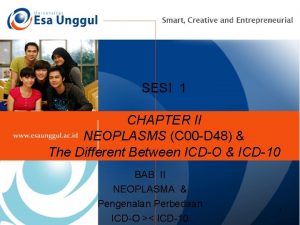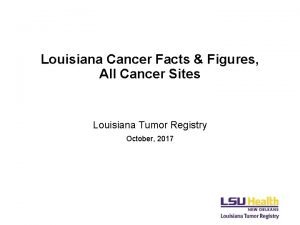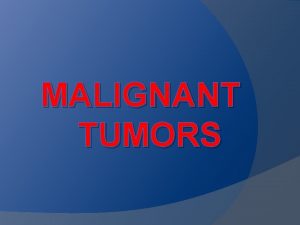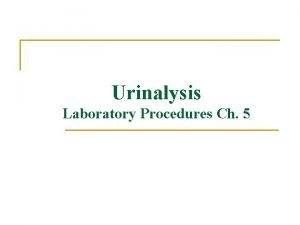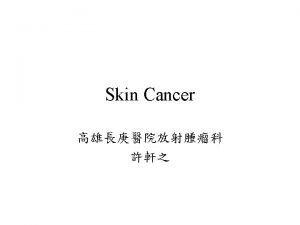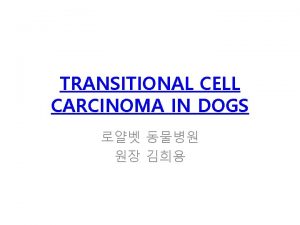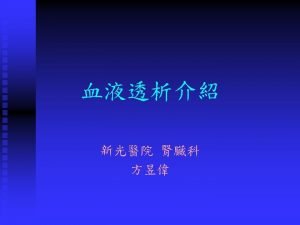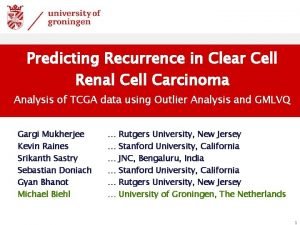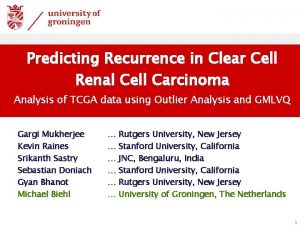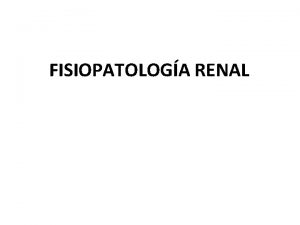Sequential Therapy in Renal Cell Carcinoma J C














- Slides: 14

Sequential Therapy in Renal Cell Carcinoma J C Nunes Marques Serviço de Oncologia Médica Centro Hospitalar de Lisboa Ocidental

Molecular Pathways and Targeted Therapies in Renal-Cell Carcinoma. Brugarolas J. N Engl J Med 2007; 356: 185 -187.

Angiogenesis: a target for anticancer therapy Rini. Clin Cancer Res 2007, 13 Faivre et al. Nat Ver Drug Disc 2007, 6 Homsi and Dand. Cancer control 2007, 14 Andrae et al. Genes Dev 2008, 22 Kerbel. N Engl J Med 2008, 358 Sonpavde et al. Expert Opin Investig Drugs 2008, 17 Ma and Adjei. CA Cancer J Clin 2009, 59

Chronology and uses of available molecular-targeted agents in metastatic renal cell carcinoma in the U. S. and Europe. Hutson T E The Oncologist 2011; 16: 14 -22


Ongoing Phase III Trial: Pazopanib vs Sunitinib in the first-line treatment of patients with m. RCC (COMPARZ) US National Institutes of Health Web Site http: //www. clinicaltrials. gov/ct 2/show/NCT 00720941 acessed 26 oct 2011




Potencial Biomarkers in m. RCC

Speculation of the best sequential therapy for m. RCC PFS of patients receiving sequential therapy (months) Sunitinib 2 11 Sorafenib 14 4, 5 Everolimus 15 4 Bevacizumab+INF 4 10, 2 Sorafenib 1 6 Sunitinib 14 6, 5 Everolimus 15 4 27, 1 Bevacizumab+INF 4 10, 2 Sunitinib 12 7 Sorafenib 14 4, 5 Everolimus 15 4 25, 7 INF 2 5 Axitinib 10 15, 7 Everolimus 15 4 Bevacizumab+INF 4 10, 2 Sorafenib 1 6 Axitinib 13 7, 4 1 Escudier et al. NEng. JMed 2007; 356 2 Motzer et al. NEng. JMed 2007; 356 4 Escudier et al. Lancet 2007; 370 10 Rixe et al. Lancet Oncol 2007; 8 12 Scharzberg et al. J Clin Oncol 2008; 26 13 Rini BI et al. J Clin Oncol 2008; 26 14 Rini BI et al. J Clin Oncol 2007; 25 15 Sablin MP et al. J Clin Oncol 2007; 25 Total PFS 19, 5 24, 7 Everolimus 15 4 27, 6 Escudier B, et al. Cancer 2009; 115 (10 Suppl): 2321 -2326

Rational of sequential therapy • each targeted agent possesses a unique biologic profile • patients have benefited from subsequent therapy with a different antiangiogenic agent • full dose of each drug can be delivered without overlapping toxicities • additional PFS benefit can been achieved • the aim of therapy is to maximize the overall benefit to patient in terms of both quality and duration of life Sablin MP, et al. J Clin Oncol. 2007; 25 (18 S): Abstract 5038 Dham A, et al. J Clin Oncol. 2007; 25(18 S): Abstract 5106 Drabkin HÁ, et al. J Clin Oncol. 2007; 25(18 S): Abstract 5041

Targeted agents in sequence Study* NCT 00903175 (RECORD-3) Sequence After 1 st line failure NCT 00732914 (SWITCH) Study type Treatment 1 Treatment 2 Randomized phase III Sunitinib Everolimus Randomized phase III Sunitinib NCT 00678392 (AXIS) Randomized phase III NCT 00474786 (TORISEL 404) Randomized phase III NCT 00678288 Randomized phase II everolimus sorafenib vs vs n 390 sunitinib Sorafenib 540 sunitinib TT or CK Sorafenib vs axitinib 650 sunitinib Sorafenib vs temsirolimus 480 sunitinib Sorafenib vs 24 Sorafenib+INF NCT 00782275 Phase II TKI(one), CK or chemo Bevacizumab +temsirolimus 46 NCT 00651482 Phase II TKI (one) CK Bevacizumab + everolimus 30 *available at http: //clinicaltrials. gov

Summary • The sequential approach with targeted agents have revealed clinical efficacy • Data suggests that there is only negligibile crossresistance between TKIs • In clinical studies of sequential therapy, everolimus was effective after treatment with one or two TKIs • In clinical studies of sequential therapy, sequential treatment was tolerable and toxicity was predictable
 Ira pré renal renal e pós renal
Ira pré renal renal e pós renal Ira pré renal renal e pós renal
Ira pré renal renal e pós renal Papillary renal cell carcinoma
Papillary renal cell carcinoma Carcinoma renal de células claras fuhrman
Carcinoma renal de células claras fuhrman Cortical and juxtamedullary nephrons difference
Cortical and juxtamedullary nephrons difference Osteosarcoma femur icd 10
Osteosarcoma femur icd 10 Squamous cell carcinoma louisiana
Squamous cell carcinoma louisiana Basal cell carcinoma
Basal cell carcinoma Squamous cell carcinoma
Squamous cell carcinoma Squamous cell carcinoma
Squamous cell carcinoma Basal cell carcinoma
Basal cell carcinoma Urchin vs hedgehog
Urchin vs hedgehog Anaplastic squamous cell
Anaplastic squamous cell Aeiou renal replacement therapy
Aeiou renal replacement therapy Transitional epithelial cells in urine
Transitional epithelial cells in urine





